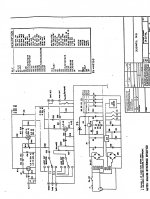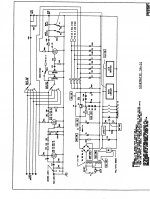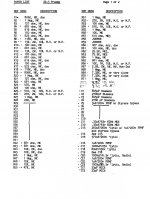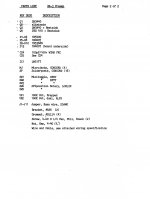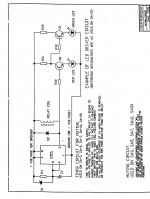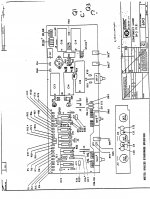I'm going to apologize in advance -- I'm not so much a newbie as someone who has limited knowledge. I work on my own stuff for fun and because I can't afford to pay someone else to do it.
I have a much-modified Counterpoint SA-3.1 preamp that I bought in non-functioning condition for $50. I've replaced the blown power transformer and some burned up diodes and resistors in the power supply, reflowed a bunch of suspicious solders, and replaced the blown regulator transistor.
It now powers up (a major victory), but I get a nasty oscillation. It sounds like an old analog synth oscillator, and as I increase the volume I can change the sound from a continuous tone down to slow clicks at max volume. It passes some signal under all the squealing but it's very low volume and distorted. I did replace the original volume pot with an Alps unit -- could an incompetent wiring job there be the culprit?
All the big electrolytics seem to be good. I'm going to be checking grounds today. There are also six big 3 mf 200v film caps on the board that I'm not sure how to test. If they were electrolytics I'd normally just replace them and see if the problem went away, but these look really expensive!
Can you guys suggest some other areas to look into?
I have a much-modified Counterpoint SA-3.1 preamp that I bought in non-functioning condition for $50. I've replaced the blown power transformer and some burned up diodes and resistors in the power supply, reflowed a bunch of suspicious solders, and replaced the blown regulator transistor.
It now powers up (a major victory), but I get a nasty oscillation. It sounds like an old analog synth oscillator, and as I increase the volume I can change the sound from a continuous tone down to slow clicks at max volume. It passes some signal under all the squealing but it's very low volume and distorted. I did replace the original volume pot with an Alps unit -- could an incompetent wiring job there be the culprit?
All the big electrolytics seem to be good. I'm going to be checking grounds today. There are also six big 3 mf 200v film caps on the board that I'm not sure how to test. If they were electrolytics I'd normally just replace them and see if the problem went away, but these look really expensive!
Can you guys suggest some other areas to look into?
Last edited:
There are also six big 3 mf 200v film caps on the board that I'm not sure how to test. If they were electrolytics I'd normally just replace them and see if the problem went away, but these look really expensive!
They don't need to be expensive. Some Wima caps will do.
Have you got grid stop resistors on all tubes?
Circuit diagram?
Schematic
Grid stop resistors? I can find components on a schematic, but I still don't know terms. I'm attaching the schematic. Can you tell me which ar the grid stop resistors? Are they the ones between the grid and ground?
FYI since I posted the original, I've double checked the grounds and they seem good, nice star grounding. I reflowed some more dry looking solders etc.
I'm going to buy a few 3 mfd film caps shortly and see if that makes a difference.
Grid stop resistors? I can find components on a schematic, but I still don't know terms. I'm attaching the schematic. Can you tell me which ar the grid stop resistors? Are they the ones between the grid and ground?
FYI since I posted the original, I've double checked the grounds and they seem good, nice star grounding. I reflowed some more dry looking solders etc.
I'm going to buy a few 3 mfd film caps shortly and see if that makes a difference.
Attachments
It may help to ask yourself why the power supply blew. Did it just give up, or did something else take far too much current? Either is possible.
Did your resoldering bridge two separate points together, or separate things which should be joined? Redoing lots of joints is as likely to introduce faults as clear them, as is changing lots of components. Adding a bit of solder to a suspect joint can actually create a dry joint - you should remove the solder, clean and start again.
Is the fault on all inputs, or just phono? Is it on main output or tape out, or both?
How do you know that the big electrolytics are good? What tests have you done?
Did your resoldering bridge two separate points together, or separate things which should be joined? Redoing lots of joints is as likely to introduce faults as clear them, as is changing lots of components. Adding a bit of solder to a suspect joint can actually create a dry joint - you should remove the solder, clean and start again.
Is the fault on all inputs, or just phono? Is it on main output or tape out, or both?
How do you know that the big electrolytics are good? What tests have you done?
It may help to ask yourself why the power supply blew. Did it just give up, or did something else take far too much current? Either is possible.
Is the fault on all inputs, or just phono? Is it on main output or tape out, or both?
How do you know that the big electrolytics are good? What tests have you done?
In answer to your first question, I'm not sure. I brought it to a tube repair guy to install the new power transformer for that very reason. I didn't want to kill the new trans. I had already replaced some violently destroyed components before he put the new trans in, so I can't be sure what caused the failure. I replaced a few melted resistors, the Q1 transistor, and a row of melted diodes. Whether these were causes or effects I'm not sure. The tech said he thought the trans just wore out.
The fault is on all inputs and appears on the main out, not the tape or input outs. One new symptom I just discovered: if I get it oscillating, the pitch is the same on all input settings except phono. The pitch rises when I switch to phono. Not sure what that means, but I'm going to focus on the RIAA section next.
The only reason I think the electrolytics are good is that the tech checked them. I think he said he bridged good caps across the 'lytics and they were all good.
Neddyboy,
If your "tech" simply bridged new caps across the existing electrolytics as a permanent repair, then I strongly suggest that you find a new tech!
I'm not trying to sound like a know-it-all, but bridging good caps across potentially bad ones is - besides being dangerous - just plain lazy and stupid. If the original caps are indeed bad (i.e. shorted), then they're nothing more than low-value bleeder resistors, and that's what probably cooked the original transformer (it's my guess that it didn't just "wear out"). Bridging them with good caps changes nothing except the capacitance; they're still in the circuit. And guess what they're doing? You guessed it, drawing a ridiculous amount of current and frying your new power transformer!
Whenever I restore an old radio set or an old amp, the electrolytic caps get replaced. Period.
And just how do I know all this, you might ask? Well, let's just say I now hesitate to use the term "fire 'er up" in the context of tube gear...
If your "tech" simply bridged new caps across the existing electrolytics as a permanent repair, then I strongly suggest that you find a new tech!
I'm not trying to sound like a know-it-all, but bridging good caps across potentially bad ones is - besides being dangerous - just plain lazy and stupid. If the original caps are indeed bad (i.e. shorted), then they're nothing more than low-value bleeder resistors, and that's what probably cooked the original transformer (it's my guess that it didn't just "wear out"). Bridging them with good caps changes nothing except the capacitance; they're still in the circuit. And guess what they're doing? You guessed it, drawing a ridiculous amount of current and frying your new power transformer!
Whenever I restore an old radio set or an old amp, the electrolytic caps get replaced. Period.
And just how do I know all this, you might ask? Well, let's just say I now hesitate to use the term "fire 'er up" in the context of tube gear...
If both channels are making this sound and since the power supply is common to both the power supply is probably the culprit. Replace all of the electrolytics. This is an early/mid 80s preamp, time for the lytics to go. Also find a new tech while you are at it. Anyone have an opinion as to the sound of this preamp? I've never heard one.
Craig
Craig
Already there Mr. Zenith. This repair guy has always done a good job on my guitar amps, but this is the first and last time I brought him a nice stereo piece. I think it was too much for him.
He definitely didn't permanently bridge new caps over the old ones. They're the same as when I sent it. Each big electrolytic does have two film caps running parallel though -- this must have been a mod because they're not on the schematic.
And yeah, I do the same with every amp I work on. Replace all the filter caps for sure, probably all the electrolytics. I didn't on this one because it seemed too new and they're all expensive Sprague Atoms. Wishful thinking I guess.
He definitely didn't permanently bridge new caps over the old ones. They're the same as when I sent it. Each big electrolytic does have two film caps running parallel though -- this must have been a mod because they're not on the schematic.
And yeah, I do the same with every amp I work on. Replace all the filter caps for sure, probably all the electrolytics. I didn't on this one because it seemed too new and they're all expensive Sprague Atoms. Wishful thinking I guess.
Excellent work, sir!
Please don't take my previous reply the wrong way. I think I may have misinterpreted your previous post.
That being said, I found out through bitter experience that slapping good caps over the old ones just creates a time bomb. At all events, it looks like you've got your work cut out for you on this one, and I'd truly like to see you succeed...
Paralleling the electrolytics with lower-value film caps is a common "mod". Some claim that it helps smooth the "harshness" of electrolytics. I've done this myself, but I honestly couldn't hear the difference. It was more work that it was worth to take 'em out, so in they stayed. To each his own. The upshot of all this is that it's no big deal electronically - unless the film caps are bad, of course (ugh)!
Please don't take my previous reply the wrong way. I think I may have misinterpreted your previous post.
That being said, I found out through bitter experience that slapping good caps over the old ones just creates a time bomb. At all events, it looks like you've got your work cut out for you on this one, and I'd truly like to see you succeed...
Paralleling the electrolytics with lower-value film caps is a common "mod". Some claim that it helps smooth the "harshness" of electrolytics. I've done this myself, but I honestly couldn't hear the difference. It was more work that it was worth to take 'em out, so in they stayed. To each his own. The upshot of all this is that it's no big deal electronically - unless the film caps are bad, of course (ugh)!
Where did you purchase the caps? I've found good prices at Antique Electronic Supply.
I'll bet that the new electrolytics will solve your problem.
I'll bet that the new electrolytics will solve your problem.
Hola Gentlemen,
I swapped out all the electrolytics this weekend but no change. I tried them naked first and still got the oscillation, so I put the parallel film caps back on.
I'll be looking at that grid stop resister tonight, R18, but beyond that I got nothin'. There are so many different versions of these things out there that most of my actual circuit doesn't match the schematic, and I can't tell if it's an aftermarket mod or just a different configuration from the factory. I've found pics of the circuit boards in these preamps and every one is different! Oy.
The inside of the chassis is as clean as I know how to make it. I reversed a bunch of iffy wiring and solders, tidied up the grounding, swapped alternate tubes in and out, replaced the electrolytics, and checked over the board with a magnifying glass for bridges and/or broken leads. I guess it's time to bite the bullet and bring it to an actual stereo audio repair shop.
I swapped out all the electrolytics this weekend but no change. I tried them naked first and still got the oscillation, so I put the parallel film caps back on.
I'll be looking at that grid stop resister tonight, R18, but beyond that I got nothin'. There are so many different versions of these things out there that most of my actual circuit doesn't match the schematic, and I can't tell if it's an aftermarket mod or just a different configuration from the factory. I've found pics of the circuit boards in these preamps and every one is different! Oy.
The inside of the chassis is as clean as I know how to make it. I reversed a bunch of iffy wiring and solders, tidied up the grounding, swapped alternate tubes in and out, replaced the electrolytics, and checked over the board with a magnifying glass for bridges and/or broken leads. I guess it's time to bite the bullet and bring it to an actual stereo audio repair shop.
- Status
- This old topic is closed. If you want to reopen this topic, contact a moderator using the "Report Post" button.
- Home
- Amplifiers
- Tubes / Valves
- Preamp Squeal
